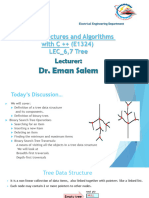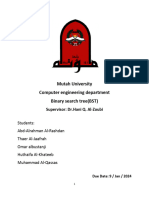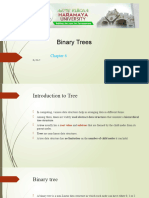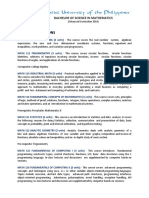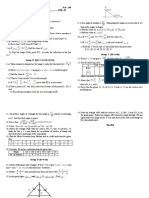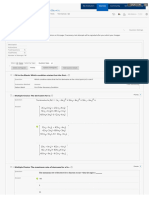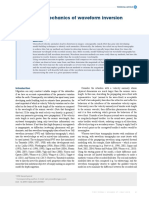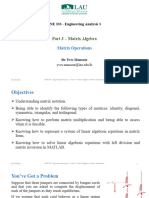SCJ2013 Data Structure & Algorithms
Binary Search Tree
Nor Bahiah Hj Ahmad
�Binary Search Tree
A binary search tree has the following
properties:
For every node n in the tree
Value of n is greater than all values in ns left
subtree.
Value of n is less than all values in ns right
subtree.
Both left subtree and right subtree are also
binary search trees
�Binary Search Trees
n
key < n
All key in
the left subtree is less
than n
20
8
key > n
All key in the right
sub-tree are
greater than n
40
15
10
18
�Binary Search Tree
Kamal
Not a Binary Search Tree
Binary Search Tree
�Advantages of Binary Search Tree
One of the most fundamental algorithms in
Computer Science and the method of choice
in many applications.
Stores keys in the nodes in a way that
searching, insertion and deletion can be
done efficiently.
Simple Implementation
Nodes in tree are dynamic
�Disadvantages of Binary Search
Tree
The shape of the tree depends on the
order of insertions, and it can be
degenerated.
When inserting or searching for an
element, the key of each visited node has
to be compared with the key of the
element to be inserted/found.
Keys in the tree may be long and the run
time may increase.
�Binary search tree
Two binary search trees representing the same set:
Average depth of a node is O(log n);
Maximum depth of a node is O(n)
�Pointer-based ADT Binary Tree
A pointer-based implementation of a
binary tree
Elements in a binary tree is
represented by using nodes.
Nodes store the information
in a tree.
Each node in the tree must
contain at least 3 fields
containing:
item
Pointer to left subtree
Pointer to right subtree
Need 2 declaration in a tree
implementation:
1. Node declaration
2. Tree declaration
�Node Implementation
leftPtr
info
rightPtr
F
Node representation
typedef char ItemType;
struct TreeNode
{
itemType info;
TreeNode *left;
TreeNode *right;
}
info, the node store char value.
left, pointer to left subtree
Right, pointer to right subtree
�Tree Implementation
class TreeType {
public:
TreeType();
~TreeType();
bool IsEmpty()const;
int NumberOfNodes()const;
void RetrieveItem(ItemType&,bool& found);
void InsertItem(ItemType);
void DeleteItem(ItemType);
void PrintTree() const;
private:
TreeNode * root;
};
The tree class declaration above, declare the binary
serach tree using class TreeType.
The tree can be accessed using root, which is a pointer
to root of the tree.
�Tree Operations
Among the tree operations in the class TreeType:
1. Initialize tree , using constructor.
2. Destroy tree, destructor.
3. Check for empty tree, IsEmpty().
4. Count number of nodes in the tree.
5. Search item in the tree
6. Insert item into a tree.
7. Delete item from tree.
8. Print all item in the tree (Inorder traversal)
�Tree Constructor
TreeType::TreeType()
{
root = NULL;
}
The constructor create an empty tree by
initializing root to NULL value.
�Tree Destructor
TreeType::~TreeType()
{
Destroy(root);
}
void Destroy(TreeNode *& tree)
{
if (tree!=NULL)
{
Destroy(tree->left);
Destroy(tree->right);
delete(tree);
}
}
Destructor will destroy all the nodes in the tree
Function Destroy() is implemented recursively whereby the
function will destroy all nodes in the left subtree first,
followed by destroying nodes in the right subtree. Lastly, the
root node will be destroyed.
�Destroying a tree using destructor
Step 1
Step 2
Destroying
third node
Destroying second node
Destroying first node
Destroying
sixth node,
root
Destroying
fifth node
Step 3
Destroying
fourth node
�IsEmpty()Function
Binary Search Tree is Empty when the root has
NULL value.
Function IsEmpty() will return True if root is NULL
and will return False if the root is not NULL.
bool IsEmpty() const
{ if (root == NULL)
return True; // tree is empty
else
return False; // tree is not empty
}
�Insert Node Into a Binary Search Tree
The insert operation will insert a node to a tree and the new
node will become leaf node.
Before the node can be inserted into a BST, the position of the
new node must be determined. This is to ensure that after
the insertion, the BST characteristics is still maintained.
Steps to insert a new node in BST
1. Find the position of the new node in the tree.
2. Allocate new memory for the new node.
3. Set NULL value to left and right pointer.
4. Assign the value to be stored in the tree.
�ADT Binary Search Tree: Insertion
root
root
Jimmy
root
Jimmy
Fizzi
Liana
Insert Jimmy to empty tree
Hazim
root
Insert Hazim to non-empty tree
Jimmy
Fizzi
Liana
Hazim
Node with value Hazim
becomes a leaf.
�Insert new node Implementation
void TreeType::InsertItem(ItemType item)
{ Insert(root, item);}
void Insert(TreeNode*& tree, ItemType item)
{
if (tree == NULL) { // base case
tree = new TreeNode;
tree->right = NULL;
tree->left = NULL;
tree->info = item;
}
else if (item < tree->info)
Insert(tree->left, item);
else
Insert(tree->right, item);
}
�Insert 5, 10, 8, 3 , 4 and 15 in a BST
Empty tree
Insert 5
Insert 10
Insert 8
Insert 3
Insert 4
�Insert 5, 10, 8, 3 , 4, 15 to a tree
Finally, Insert the last node; 15.
Time complexity = O(height of the tree)
�Searching from BST
From the figure, if we search for value 20, then we are
done at the root.
If we search for a value < 20, then searching will be at the
left subtree.
If we are searching for a value > 20, then searching will be
at the right subtree.
�Searching from BST
Search value 10 from the tree
1. Compare 10 with value 20 (at root), go to left subtree.
2. Compare 10 with 8, go to right subtree.
3. Compare 10 with 15, go to left subtree.
4. Compare 10 with 10, value is found.
Time complexity = O(height of the tree)
= O(4)
�Searching: RetrieveItem() function
�Delete a Node from a Tree
When a node is deleted, the children of the
deleted node must be taken care of to ensure
that the property of the search tree is
maintained.
There are 3 possible cases to delete a node in
a tree:
1. Delete a leaf
2. Delete a node with one child
3. Delete a node that has two children
�Delete a Leaf Node
The node to be deleted is a leaf
Set the pointer in Ns parent to NULL and delete
it immediately
Example : Delete leaf Node: Z
Before delete
After delete Z
�Delete a Node With One Child
Delete node R.
Adjust a pointer from the parent to bypass that node
Before delete R
After delete R
�Delete a Node With Two Children
To delete a node N that has two children.
Locate another node M that is easier to delete
M is the leftmost node in Ns right subtree
M will have no more than one child
Ms search key is called the inorder successor of
Ns search key
Copy the item that is in M to N
Remove the node M from the tree
�Delete a Node with 2 Children
Delete Q that has 2 children
�Delete a Node With 2 Children
Delete 2 with 2 children.
Replace the key of that node with the minimum element
at the right subtree.
Delete the minimum element that has either no child or
only right child because if it has a left child, that left child
would be smaller and would have been chosen.
Delete 2
Replace with 3
and delete
node 3
�Print Values in BST
Function PrintTree() print all values in BST using inorder
traversal. Print() function will be called recursively, starting
from left subtree, root and right subtree.
�Inorder traversal of BST
Print out all the keys in sorted order
Inorder: 2, 3, 4, 6, 7, 9, 13, 15, 17, 18, 20
�The Efficiency of Binary Search Tree
Operations
The maximum number of comparisons required by any
binary search tree operation is the number of nodes along
the longest path from root to a leaf, which is the trees
height.
The order in which insertion and deletion operations are
performed on a binary search tree affects its height.
Insertion in random order produces a binary search tree
that has near-minimum height.
Insertion in sequential order produces a binary search tree
that is unbalanced and has height = O(n).
�The Efficiency of Binary Search Tree
Operations
�Summary and Conclusion
Binary search trees come in many shapes. The shape
of the tree determines the efficiency of its operations
The height of a binary search tree with n nodes can
range from a minimum of Olog2(n + 1) to a maximum
of n.
The efficiency of binary search tree operations:
�References
Nor Bahiah et al. Struktur data & algoritma
menggunakan C++. Penerbit UTM. 2005.
Frank M. Carano, Janet J Prichard. Data
Abstraction and problem solving with C++
Walls and Mirrors. 5th edition (2007). Addision
Wesley.


